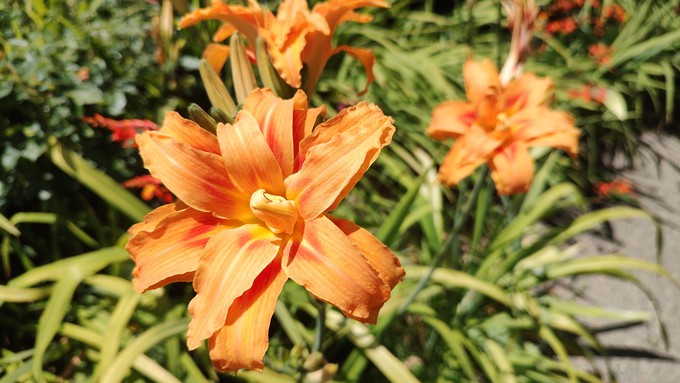
Vegetables and flowers benefit from cooler than average temperatures

A double orange daylily blooms on the first day of summer in Sacramento. Mild June weather may extend bloom season for many late spring favorites. Debbie Arrington
Our (relative) cool streak continues, and that’s good news for our tomatoes and squash.
Summer officially started at 7:57 a.m. Wednesday and, according to the National Weather Service, our new season starts like the last one ended – with below-average temperatures.
“Happy Summer Solstice!” tweeted the NWS Sacramento office on Wednesday morning. “We’re feeling cool for the Summer with these high temperatures. Our highs start to warm slightly as we head into the weekend but our temps will still be below average!”
The forecast calls for Sacramento highs of only 78 degrees on Thursday and 79 on Friday – 10 degrees below our late-June average. We’re expected to warm up slightly to 82 degrees on Saturday and Sunday and can expect more low 80s heading into next week.
So far, June’s daytime highs are averaging four degrees below normal – 82.6 compared to 86.7, says the weather service. That comes after a coolish May with daytime highs averaging three degrees below normal (77.2 compared to 80.3).
While daytime temperatures remain on the cool side, we’re staying relatively warm after dark with overnight lows in the mid 50s. June’s average lows are barely below normal, averaging 55.2 degrees (compared to our historic average of 55.9). That helps soil retain its warmth and keeps summer vegetables growing fast.
Coupled with these mild days, this is ideal weather for rapid development in the vegetable garden. Light breezes should help pollinate tomatoes. Bees and other pollinators love this weather, too; setting new squash and melons shouldn’t be a problem either.
The key will be water. No rain is anywhere in our forecast, so irrigate these fast-growing veggies deeply at least once or twice a week.
Also benefiting from cooler weather: Spring and early summer flowers. Expect our bloom season to continue with big flourishes of roses and lilies.
On the minus side, lots of insects love these mild but warm temperatures. Watch out for explosions of aphids, whiteflies and spider mites.
Also enjoying these days in the 70s: Powdery mildew. Snip off and dispose of infected foliage.
This cool streak is unlikely to last – this is summer in Sacramento. The last June without at least one triple-digit day: 1998.
Our current weather pattern is similar to 2009, notes forecasters. That June also started out with below-average temperatures, but got hot in a hurry; Sacramento hit 108 degrees on June 28 that year.
Long-range predictions for July 2023 say Sacramento will be typically hot and maybe a notch above normal. Forecasters expect the month to average highs of 94 degrees; normal is 92.
For more on Sacramento forecasts: https://www.weather.gov/sto/.
Comments
0 comments have been posted.Sacramento Digs Gardening to your inbox.
Sites We Like
Garden Checklist for week of April 21
This week there’s plenty to keep gardeners busy. With no rain in the immediate forecast, remember to irrigate any new transplants.
* Weed, weed, weed! Get them before they flower and go to seed.
* April is the last chance to plant citrus trees such as dwarf orange, lemon and kumquat. These trees also look good in landscaping and provide fresh fruit in winter.
* Smell orange blossoms? Feed citrus trees with a low dose of balanced fertilizer (such as 10-10-10) during bloom to help set fruit. Keep an eye out for ants.
* Apply slow-release fertilizer to the lawn.
* Thoroughly clean debris from the bottom of outdoor ponds or fountains.
* Spring brings a flush of rapid growth, and that means your garden is really hungry. Feed shrubs and trees with a slow-release fertilizer. Or mulch with a 1-inch layer of compost.
* Azaleas and camellias looking a little yellow? If leaves are turning yellow between the veins, give them a boost with chelated iron.
* Trim dead flowers but not leaves from spring-flowering bulbs such as daffodils and tulips. Those leaves gather energy to create next year's flowers. Also, give the bulbs a fertilizer boost after bloom.
* Pinch chrysanthemums back to 12 inches for fall flowers. Cut old stems to the ground.
* Mulch around plants to conserve moisture and control weeds.
* From seed, plant beans, beets, cantaloupes, carrots, corn, cucumbers, melons, radishes and squash.
* Plant onion sets.
* In the flower garden, plant seeds for asters, cosmos, celosia, marigolds, salvia, sunflowers and zinnias.
* Transplant petunias, zinnias, geraniums and other summer bloomers.
* Plant perennials and dahlia tubers for summer bloom.
* Mid to late April is about the last chance to plant summer bulbs, such as gladiolus and tuberous begonias.
* Transplant lettuce seedlings. Choose varieties that mature quickly such as loose leaf.